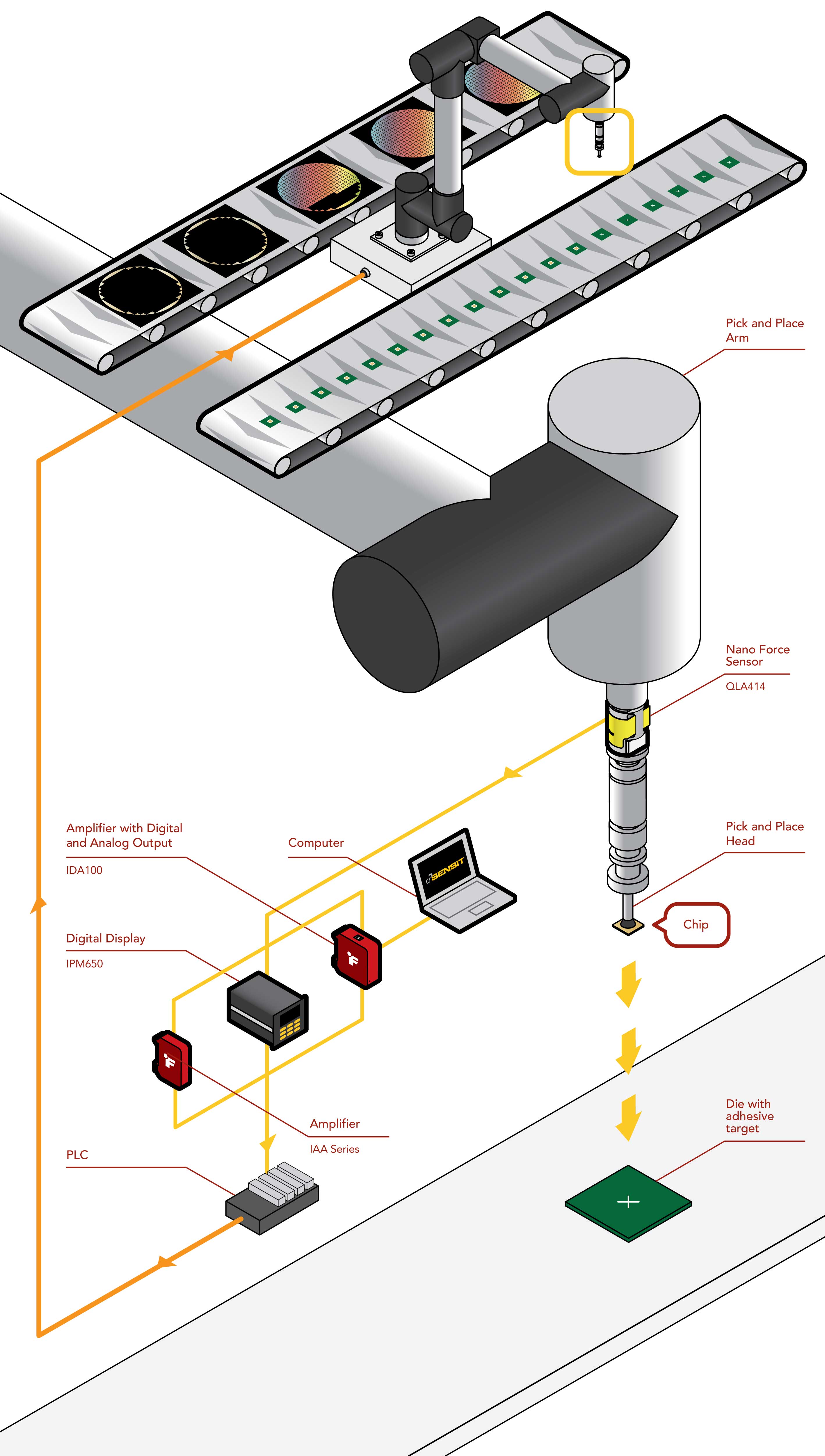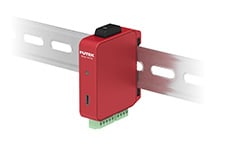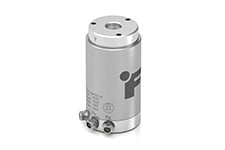What is a Pick and Place Robot?
In the intricate landscape of semiconductor manufacturing, the pick and place robot stands as a crucial player. Often referred to as a pick and place machine, this robotic system is designed for the automated handling and precise placement of electronic components onto circuit boards. In the semiconductor industry, efficiency and accuracy are paramount, making pick and place robots indispensable for optimizing production workflows.
Why measure the force on Pick and Place Machines?
Pick-and-place robots operate continuously, maintaining a steady pace 24/7. Force sensors mounted along with their end-effector (i.e. suction cup) provide data about the contact pressure onto the manipulated object. Micro miniature force sensors, such as the QLA414 Nano Force Sensor, introduce an additional layer of valuable data by offering haptic feedback. This feedback is crucial when handling delicate objects that require precise and adjustable contact pressure, ranging from semiconductors to eggs.
More specifically, Die Attach process, also usually known in the semiconductor industry as Die Bonding or Die Mount, is the process of bonding a silicon chip to the Die pad of the support structure. Fragile semiconductor chips require delicate handling prior to packaging. During Through-Silicon Via (TSV), eutectic, epoxy, or solder-based die attach processes, consistent force must be applied to the chip. Incorrect die attach force application causes broken chips and incomplete bonds. Load cells incorporated into the die attach tooling enable closed-loop control during this delicate process
How Load Cells are Used in Pick and Place Force Measurement?
Load cells, designed for precision force measurement, find a specialized application in pick and place force measurement within pick and place machines. These load cells are strategically incorporated into the robot end effector to gauge the force exerted during the pick-and-place process. This integration ensures that the robotic system operates within specified force parameters, mitigating the risk of damage to sensitive semiconductor components.
The data obtained from load cells enables engineers to fine-tune the robotic system, optimizing force application for different components and assembly scenarios. In particular, automatic SMT pick and place machines benefit from load cells by offering precise force control, minimizing the chances of misalignment or damage to components during the intricate assembly process.
FUTEK's Nano Force Sensor – Revolutionizing Pick and Place Force Measurement
QLA414 NANO force sensor is the smallest tension and compression force measurement solution of its kind. The 4mm x 5mm Nano Force sensor, opens up a world of possibilities for industries such as advanced automation, semiconductor, electronics assembly, and robot end effector contact force measurement.
The NANO force sensor features M1 threaded double-sided mounting provisions and unique thru-hole design allowing for flexible slide on, weld-on over the tube, wire, or shaft integration options. Nano sensors multi element, side load compensated 1000 Ohm full-bridge instrumentation is encased with laser-welded construction with patent-pending non-active interconnect packaging providing environmental protection. It allows for high accuracy in 5lb and 10lb capacities with ultra-low deflection, and high natural frequency response up to 98KHz.
Additionally, with force measurement capabilities up to 50lb, are also available for OEM applications, including IP67 and autoclavable sensors for the semiconductor industry.
Amidst the vast array of load cell options available, FUTEK recommends the QLA414 Nano Force Sensor for its unparalleled precision and reliability. When positioned at the tip of the robot end effector, the QLA414 ensures inline force measurement during the pick-and-place operation. It is crucial to note that extraneous loads, commonly known as off-center loads, must be considered when using load cells on pick and place force measurement.
How it Works
A QLA414 Nano Force Sensor is installed in line the pick and place head and armature.
As the armature presses the chip down onto the die during the attach process, the QLA414 Nano Force Sensor measures the force applied.
The force applied is then displayed by the SensLog Handheld Display or IPM650 Panel Mount Display.
Utilizing the IAA Series analog amplifier or the analog outputs from the IDA100 or IPM650, an amplified output can be sent to a PLC for automated die-attach processes.
IDA100 signal conditioner is also equipped with a USB digital output which can be connected to a computer set up with with FUTEK's SENSIT™ Test and Measurement Software operators can log, graph, and capture all the data on a PC.
Contact Us
Please Contact Us with questions.
What is a Pick and Place Robot?
In the intricate landscape of semiconductor manufacturing, the pick and place robot stands as a crucial player. Often referred to as a pick and place machine, this robotic system is designed for the automated handling and precise placement of electronic components onto circuit boards. In the semiconductor industry, efficiency and accuracy are paramount, making pick and place robots indispensable for optimizing production workflows.
Why measure the force on Pick and Place Machines?
Pick-and-place robots operate continuously, maintaining a steady pace 24/7. Force sensors mounted along with their end-effector (i.e. suction cup) provide data about the contact pressure onto the manipulated object. Micro miniature force sensors, such as the QLA414 Nano Force Sensor, introduce an additional layer of valuable data by offering haptic feedback. This feedback is crucial when handling delicate objects that require precise and adjustable contact pressure, ranging from semiconductors to eggs.
More specifically, Die Attach process, also usually known in the semiconductor industry as Die Bonding or Die Mount, is the process of bonding a silicon chip to the Die pad of the support structure. Fragile semiconductor chips require delicate handling prior to packaging. During Through-Silicon Via (TSV), eutectic, epoxy, or solder-based die attach processes, consistent force must be applied to the chip. Incorrect die attach force application causes broken chips and incomplete bonds. Load cells incorporated into the die attach tooling enable closed-loop control during this delicate process
How Load Cells are Used in Pick and Place Force Measurement?
Load cells, designed for precision force measurement, find a specialized application in pick and place force measurement within pick and place machines. These load cells are strategically incorporated into the robot end effector to gauge the force exerted during the pick-and-place process. This integration ensures that the robotic system operates within specified force parameters, mitigating the risk of damage to sensitive semiconductor components.
The data obtained from load cells enables engineers to fine-tune the robotic system, optimizing force application for different components and assembly scenarios. In particular, automatic SMT pick and place machines benefit from load cells by offering precise force control, minimizing the chances of misalignment or damage to components during the intricate assembly process.
FUTEK's Nano Force Sensor – Revolutionizing Pick and Place Force Measurement
QLA414 NANO force sensor is the smallest tension and compression force measurement solution of its kind. The 4mm x 5mm Nano Force sensor, opens up a world of possibilities for industries such as advanced automation, semiconductor, electronics assembly, and robot end effector contact force measurement.
The NANO force sensor features M1 threaded double-sided mounting provisions and unique thru-hole design allowing for flexible slide on, weld-on over the tube, wire, or shaft integration options. Nano sensors multi element, side load compensated 1000 Ohm full-bridge instrumentation is encased with laser-welded construction with patent-pending non-active interconnect packaging providing environmental protection. It allows for high accuracy in 5lb and 10lb capacities with ultra-low deflection, and high natural frequency response up to 98KHz.
Additionally, with force measurement capabilities up to 50lb, are also available for OEM applications, including IP67 and autoclavable sensors for the semiconductor industry.
Amidst the vast array of load cell options available, FUTEK recommends the QLA414 Nano Force Sensor for its unparalleled precision and reliability. When positioned at the tip of the robot end effector, the QLA414 ensures inline force measurement during the pick-and-place operation. It is crucial to note that extraneous loads, commonly known as off-center loads, must be considered when using load cells on pick and place force measurement.






